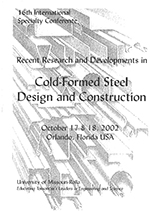Session Dates
17 Oct 2002
Abstract
The paper describes an experimental investigation into the column strengths of cold-formed stainless steel rectangular hollow sections (RHS). A series of tests consisting of four cross-section sizes was compressed between fixed ends. The tests were performed over a range of column lengths, such that column curves were obtained for each series of tests. The failure modes of the columns involved local buckling, overall flexural buckling and interaction of local and overall buckling. The test strengths are compared with the design strengths predicted using the American, Australian/New Zealand and European specifications for cold-formed stainless steel structures. The design strengths were calculated using the material properties obtained from tensile coupon tests and stub column tests. The reliability of these design rules is evaluated using reliability analysis. It is concluded that the design strengths predicted by the three specifications are generally conservative. The reliability analysis shown that the design strengths predicted by the Australian/New Zealand Standard are generally more reliable than the design strengths predicted by the American and European specifications.
Department(s)
Civil, Architectural and Environmental Engineering
Research Center/Lab(s)
Wei-Wen Yu Center for Cold-Formed Steel Structures
Meeting Name
16th International Specialty Conference on Cold-Formed Steel Structures
Publisher
University of Missouri--Rolla
Document Version
Final Version
Rights
© 2002 University of Missouri--Rolla, All rights reserved.
Document Type
Article - Conference proceedings
File Type
text
Language
English
Recommended Citation
Young, Ben and Liu, Yahua, "Experimental Investigation of Cold-formed Stainless Steel RHS Columns" (2002). CCFSS Proceedings of International Specialty Conference on Cold-Formed Steel Structures (1971 - 2018). 1.
https://scholarsmine.mst.edu/isccss/16iccfss/16iccfss-session6/1
Experimental Investigation of Cold-formed Stainless Steel RHS Columns
The paper describes an experimental investigation into the column strengths of cold-formed stainless steel rectangular hollow sections (RHS). A series of tests consisting of four cross-section sizes was compressed between fixed ends. The tests were performed over a range of column lengths, such that column curves were obtained for each series of tests. The failure modes of the columns involved local buckling, overall flexural buckling and interaction of local and overall buckling. The test strengths are compared with the design strengths predicted using the American, Australian/New Zealand and European specifications for cold-formed stainless steel structures. The design strengths were calculated using the material properties obtained from tensile coupon tests and stub column tests. The reliability of these design rules is evaluated using reliability analysis. It is concluded that the design strengths predicted by the three specifications are generally conservative. The reliability analysis shown that the design strengths predicted by the Australian/New Zealand Standard are generally more reliable than the design strengths predicted by the American and European specifications.



